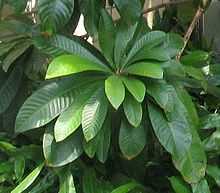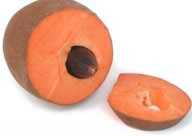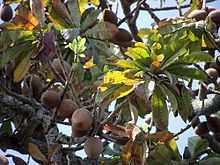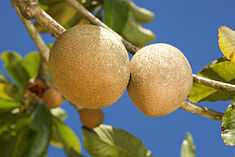Pouteria sapota
| ||||||||||||||||||||||||||||||||||||||||||||||||||||||||||||||||||||||||||||||||||||||||||||||||
Pouteria sapota, mamey sapote, is a species of tree native to Central America, naturally ranging from southern Mexico to southern Costa Rica. Today, the tree is cultivated not only in Mexico, but also in Central America, the Caribbean, and South Florida for its fruit, which is commonly eaten in many Latin American countries. It has different names depending on the country: mamey (Cuba), zapote colorado (Costa Rica), níspero and zapote rojo (South America), among others.
Description


Mamey sapote is a large and highly ornamental evergreen tree that can reach a height of 15 to 45 meters (60 to 140 feet) at maturity. Like most fruit trees, it is mainly propagated by grafting, which ensures the new plant has the same characteristics as the parent, especially its fruit. It is also considerably faster than growing trees by seed.
The leaves are pointed at both ends, 4 to 12 inches in length and grow in clusters at the ends of branches.
The fruit is about 10 to 25 cm (4 to 10 inches) long and 8 to 12 cm (3 to 5 inches) wide and has flesh ranging in color from pink to orange to red. The brown skin has a texture somewhat between sandpaper and the fuzz on a peach. The fruit's texture is creamy and soft. A mamey sapote is ripe when the flesh is pink when a fleck of the skin is removed. The flesh should give slightly, as with a ripe kiwifruit.
The mamey sapote is related to other sapotes such as sapodilla (Manilkara zapota), abiu (P. caimito) and canistel (P. campechiana), but unrelated to the black sapote (Diospyros digyna) and white sapote (Casimiroa edulis).[2] It should not be confused with the mammee apple (Mammea americana).

Uses
The fruit is eaten raw or made into milkshakes, smoothies, ice cream and fruit bars. It can be used to produce marmalade and jelly.[3] Some consider the fruit to be an aphrodisiac. Some beauty products use oil pressed from the seed,[4] otherwise known as sapayul oil.[5]
Nutrition
The fruit is an excellent source of vitamin B6 and vitamin C, and is a good source of riboflavin, niacin, vitamin E, manganese, potassium and dietary fiber. Research has identified several new carotenoids from the ripe fruit.[6][7]
Synonyms[1]
- Achras mammosa Bonpl. ex Miq. nom. illeg.
- Achras zapota var. major Jacq.
- Bassia jussaei Griseb.
- Bassia jussiaei Tussac
- Calocarpum huastecanum Gilly
- Calocarpum mammosum var. bonplandii (Kunth) Pierre
- Calocarpum mammosum var. candollei (Pierre) Pierre
- Calocarpum mammosum var. ovoideum (Pierre) Pierre
- Calocarpum sapota (Jacq.) Merr.
- Calospermum mammosum var. bonplandii (Kunth) Pierre
- Calospermum mammosum var. candollei Pierre
- Calospermum mammosum var. ovoidea Pierre
- Calospermum parvum Pierre
- Lucuma bonplandiiv Kunth
- Sapota mammosa Mill.
- Sideroxylon sapota Jacq.
- Sideroxylum sapota Jacq.
See also
References
| Wikimedia Commons has media related to Pouteria sapota. |
| Wikispecies has information related to: Pouteria sapota |
- ↑ 1.0 1.1 "The Plant List".
- ↑ Boning, Charles R. (2006). Florida’s Best Fruiting Plants: Native and Exotic Trees, Shrubs, and Vines. Sarasota, Florida: Pineapple Press, Inc. p. 139. ISBN 1561643726.
- ↑ Jamieson, G. S.; McKinney, R. S. (1931). "Sapote (mammy apple) seed and oil". Oil & Fat Industries 8: 255. doi:10.1007/BF02574575.
- ↑ Molly Chadwick (11 January 2011). "Emerald Forest® Botanical Hair Care With Rainforest Sapayul Commits to More Natural Products With Introduction of Paraben Free Shampoos And Conditioners". Encinitas, CA: PRWEB. Retrieved 29 August 2014.
Sapayul oil comes from the seeds of Sapote, a fruit indigenous to the Central American rainforests and an ancient Mayan secret for beautiful, soft, and shiny hair.
- ↑ Anita Grant (14 December 2006). "Organic Sapote Seed Oil (inci: Pouteria Sapota, Zapote, Mamey Sapote, Zapayul, Sapayul)". anitagrant.com's photostream. Flickr. Retrieved 25 August 2011.
Organic Sapote Seed Oil (inci: Pouteria Sapota, Zapote, Mamey Sapote, Zapayul, Sapayul)
- ↑ Murillo E, McLean R, Britton G, Agócs A, Nagy V, Deli J (2011). "Sapotexanthin, an A-provitamin carotenoid from red mamey (Pouteria sapota).". J Nat Prod. 74 (2): 283–5. doi:10.1021/np1006982. PMID 21214217.
- ↑ Gulyás-Fekete G, Murillo E, Kurtán T, Papp T, Illyés TZ, Drahos L, Visy J, Agócs A, Turcsi E, Deli J (2013). "Cryptocapsinepoxide-Type Carotenoids from Red Mamey, Pouteria sapota.". J Nat Prod. 76 (4): 607–14. doi:10.1021/np3007827. PMID 23451823.
